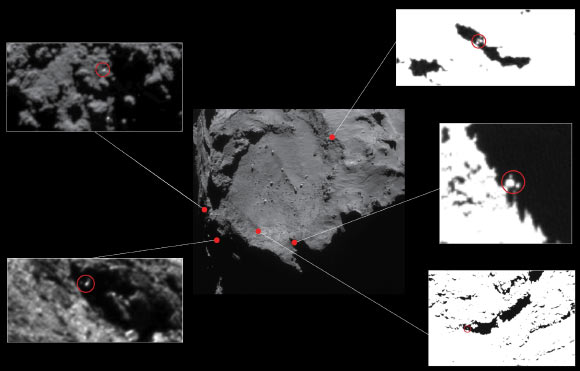The European Space Agency’s (ESA) Philae lander has woken up after seven months in hibernation on the surface of 67P/Churyumov-Gerasimenko.

The Philae lander at work on Comet 67P/Churyumov-Gerasimenko. Image credit: ESA / AOES Medialab.
“Philae is doing very well. It has an operating temperature of minus 31 degrees Fahrenheit (minus 35 degrees Celsius) and has 24 Watts available. The lander is ready for operations,” said Dr Stephan Ulamec, the Rosetta mission’s Philae Lander Manager at the DLR German Aerospace Center.
For more than one minute the lander ‘spoke’ with the team, via its parent orbiter Rosetta. More than 300 packets of data were received and analyzed by the scientists.
The signals were received at ESA’s European Space Operations Center in Darmstadt, Germany at 4:28 p.m. EDT (01:28 p.m. PDT, 8:28 p.m. GMT, 10:28 p.m. CET) on 13 June.
When analyzing the status data it became clear that Philae also must have been awake earlier.
“We have also received historical data – so far, however, the lander had not been able to contact us earlier,” Dr Ulamec said.

Approximate locations of five lander candidates initially identified in Rosetta’s OSIRIS Narrow Angle Camera images taken in December 2014, from a distance of about 20 km from the center of the comet. The candidates are circled in the close-ups, identifying Philae-sized features about 1–2 m across. The contrast has been stretched in some of the images to better reveal the candidates. Image credit: ESA / Rosetta / NavCam / MPS for OSIRIS Team / UPD / LAM / IAA / SSO / INTA / UPM / DASP / IDA / CC BY-SA IGO 3.0.
The 100-kilogram lander shut down on November 15, 2014 after being in operation on the comet for about 60 hours. Since March 12, 2015 the communication unit on Rosetta was turned on to listen out for the lander.
Now the team is waiting for the next contact. There are still more than 8,000 data packets in the lander’s mass memory which will give the mission scientists information on what happened to the lander in the past few days on the comet.
The team is also searching for the current location of Philae. “Accurately locating the lander is of great scientific value, in particular for the joint orbiter and lander CONSERT experiment to get the best assessment of the interior structure of the comet nucleus,” said Dr Matt Taylor, ESA’s Rosetta project scientist.
“Knowing where Philae is would provide important context for the lander measurements and valuable information for its future operation.”







